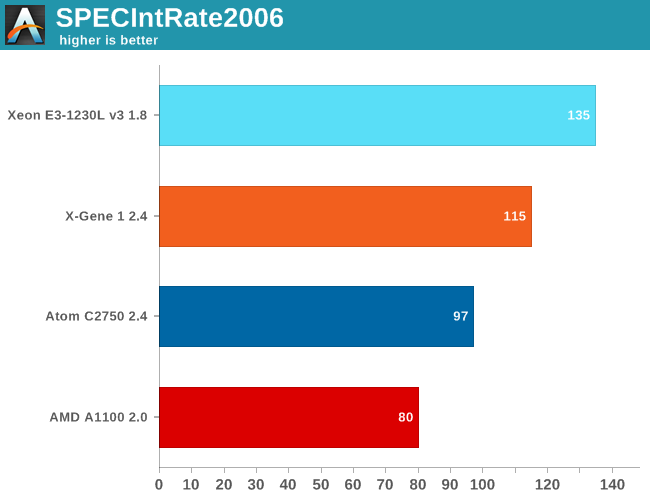ARM Challenging Intel in the Server Market: An Overview
by Johan De Gelas on December 16, 2014 10:00 AM ESTPerformance
The first SPECIntRate 2006 estimates were published by "CPU meister" Andreas Stiller. If we combine his findings with what we know and what is available at SPEC.org, we get the benchmark graph below.

Intel's own published SPECintrate scores are up to 20% higher, so at first sight the ARM competition is not there yet. However, we prefer to show the "lower numbers" as they have not been benchmarked with masterfully set ICC configuration settings.
The most aggressive architecture, the X-Gene, is quite a bit slower than the Xeon E3-1230L. The latter needs about 40W per node (SoC + chipset), while an X-Gene node would need almost 60W. AppliedMicro really needs the 28nm 2.8GHz X-Gene 2, which apparently can offer a 50% better performance per watt increase in SPECintrate 2006.
However, we have shown you that while SPECintrate 2006 is the standard often used, popular with most CPU designers, analysts and academic researchers, it is a pretty bad predictor of server performance. We should not discount the chances of the server ARM SoCs too quickly. A mediocre SPECint SoC can still perform well in server applications.










78 Comments
View All Comments
jhh - Tuesday, December 16, 2014 - link
SPARC and Power have had trouble keeping up with Moore's law, as neither sold enough to amortize R&D to push out innovation at the same rate as Intel. As Moore's law comes to an end, this will stop being a unique Intel advantage. It just might be too late for both of them. One can see the pressure on IBM, with their opening the Power architecture in similar ways to ARM. Both POWER and SPARC have to keep up to porting drivers to their Unix implementations, while the device manufacturers either write drivers for Linux or don't get volume. I just can't see either POWER or SPARC being cost effective over the long run. And, when others see the same thing, they aren't going to be excited about porting application software to those platforms.ARM needs to have a good performance/power and performance/cost ratio to get people excited to buy something other than Intel. They are certainly getting enough volume from the low-end to make investment on high-end parts. So far, I'm not excited enough to recommend any ARM proof-of-concept though.
Kevin G - Wednesday, December 17, 2014 - link
IBM always had a licensing model similar to ARM with PowerPC cores. The only thing really new here is that IBM is licensing out there flagship POWER chip in the same manner. Despite Intel having a process advantage, IBM was able to keep up in performance. (The 45 mm based 8POWER7 was generally faster than the 32 mm 10 core Westmere-EX.) There will always be a market for top performance but you are correct that sustaining on just that customer base is unwise.IBM does realize that their software licensing model to subsidize hardware R&D was not sustainable. So while you can't run AIX, you can get a POWER8 box for less than $3k now.
OreoCookie - Wednesday, December 17, 2014 - link
Really, just $3000? Wow, how times have changed, I remember ~12 years ago that a single Alpha CPU cost that much (the department I was working for had a workstation fail, fortunately under warranty, because otherwise they would have had to pay for 2 new CPUs and new RAM worth about 15,000 German Marks).Ratman6161 - Wednesday, December 17, 2014 - link
"The general lower cost of Linux and open source software" While it's true that the cost of a Linux OS including support is lower than an equivalent Windows OS, in the larger scheme of things the cost of Windows and even VMware becomes little more than background noise in the total cost of operations. Try pricing out an Oracle DB for example and you find that the cost of that software dwarfs the price of the hardware it's running on as well as whatever the OS is costing. Ditto with most "enterprise software".lefty2 - Tuesday, December 16, 2014 - link
Intel has another big advantage over ARM, which everyone seems to have forgotten about, and that is software compatibilty. 64-bit ARM server software is still a work in progress. The stuff that's being worked on at the moment is open source. Once that's finished you still have to convince clients to convert their proprietary software to ARM.JohanAnandtech - Tuesday, December 16, 2014 - link
Don't you think that the open source software that has been/is ported now is enough? Apache/PHP/MySQL, Memcached and Hadoop...that is a massive server market. And there is little stopping Microsoft to invest in ARM software too. Just VMware might be a bit tricky, but I don't think the software is a problem.Kevin G - Wednesday, December 17, 2014 - link
Actually VMware has said some less that flattering about ARM. Xen is the main hyper visor on ARM for the moment.goop666666 - Thursday, December 25, 2014 - link
Yeah, recompiling is so very hard. Essentially what you're saying is that Intel is for legacy systems and software that is poorly written. That is a large enough market, but doesn't apply to hyperscale deployments, which are the future.gostan - Tuesday, December 16, 2014 - link
great article by Johan as always.but the argument is muted. we have heard this tune before.
the hardware might be cheaper. the power bill might be cheaper. wait until you see the software maintenance cost. custom software needs 'custom' pricing.
besides, arm has no cutting edge fab process to back them.
JohanAnandtech - Tuesday, December 16, 2014 - link
You do not need expensive software to create a server market these days. Just look how many webservers are running the LAMP stack.